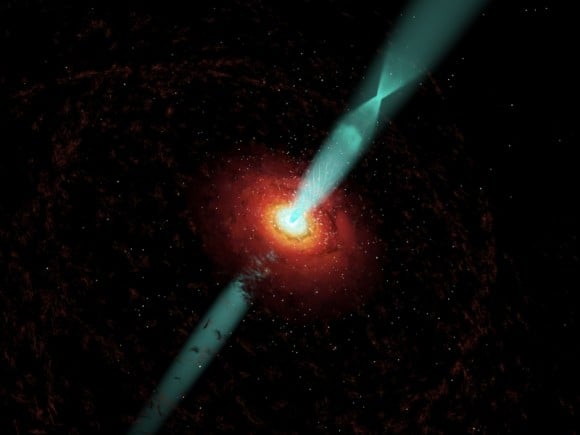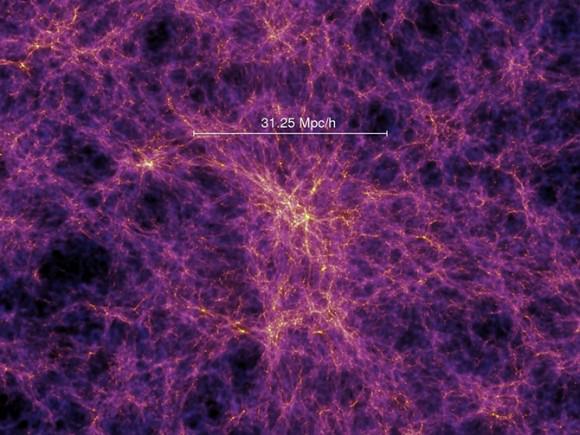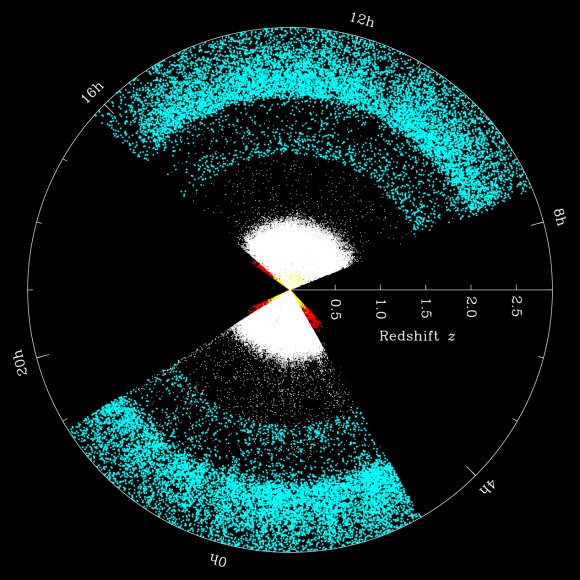In 1974, astronomers detected a massive source of radio wave emissions coming from the center of our galaxy. Within a few decades time, it was concluded that the radio wave source corresponded to a particularly large, spinning black hole. Known as Sagittarius A, this particular black hole is so large that only the designation "supermassive" would do. Since its discovery, astronomers have come to conclude that supermassive black holes (SMBHs) lie at the center of almost all of the known massive galaxies.
But thanks to a recent radio imaging by a team of researchers from
the University of Cape Town and University of the Western Cape, in South Africa,
it has been further determined that
in a region of the distant universe, the SMBHs are all spinning out radio jets in the same direction. This finding, which shows an alignment of the jets of galaxies over a large volume of space, is the first of its kind, and could tell us much about the early Universe.
This research, which appeared recently in the
Monthly Notices of the Royal Astronomical Society
, was made possible thanks to a
three-year deep radio imaging survey conducted by the Giant Metrewave Radio Telescope (GMRT) in India. After examining the radio waves coming from a region of space called ELAIS-N1, the South African research team found that the jets being produced by these galaxies were all in alignment.
[caption id="attachment_13842" align="aligncenter" width="580"]
Artist's impression of a supermassive black hole. Credit: NRAO
[/caption]
This finding could only be explained by venturing that the SMBHs creating them were all spinning in the same direction, which in turn reveals something rather interesting about how these black holes came to be. In essence, the only likely reason why multiple SMBHs could be spinning in the same direction over a large volume of space is if they were the result of primordial mass fluctuations in the early universe.
As Prof. Andrew Russ Taylor - the joint UWC/UCT SKA Chair, Director of the recently-launched Inter-University Institute for Data Intensive Astronomy, and principal author of the Monthly Notices study - explained: "Since these black holes don’t know about each other, or have any way of exchanging information or influencing each other directly over such vast scales, this spin alignment must have occurred during the formation of the galaxies in the early universe."
This was rather surprising, and something the research team wasn't prepared for. Initially, the goal of the project was to explore the faintest radio sources in the universe using the latest generation of radio telescopes; which, it was hoped, would provide a preview of what the next-generation of telescopes like South Africa's
MeerKAT telescope and the Square Kilometre Array (SKA) will provide once they go online.
While previous studies have shown that there are deviations in the orientations of certain galaxies, this was the first time that astronomers were able to use the jets produced by the SMBA holes to
reveal their alignments. After noting the symmetry that was apparent between them, the research team considered several options as to why
an alignment in galaxies (even on scales larger than galaxy clusters)
might be.
[caption id="attachment_102643" align="aligncenter" width="580"]
By studying the large-scale spin distribution of SMBHs could tell us much about the matter fluctuations that gave rise to the large-scale structure of the Universe. Credit: Volker Springel/Virgo Consortium.
[/caption]
However, it is important to note that a large-scale spin distribution of this kind has never been predicted by theories. Such an unknown phenomenon certainly presents a challenge when it comes to prevailing theories about the origins of the Universe, which will have to be revised somewhat to account for this.
While earlier studies have detected deviations from uniformity in the orientations of galaxies, this was the first time that radio jets were used to measure their alignment. This was made possible thanks to the sensitivity of the radio images used, which also benefitted from the fact that measurements of the intensity of radio emissions are not effected by things like scattering,
extinction and Faraday Rotation (which may have effected other studies).
Furthermore, the presence of alignments of this nature could shed light on the orientation and evolution of these galaxies, particularly in relation to large-scale structures. They could also help astronomer to learn more about the motions in the primordial matter fluctuations that gave rise to the current structure of the Universe. As Taylor and the other authors of the paper also note,it will be interesting to compare this with predictions of angular momentum structure from universe simulations.
In recent years, several simulations have been produced to model the large-sale structure of the Universe and how it evolved. These include, but are not limited to, the FastSound project - which has been surveying galaxies in the Universe using the Subaru Telescope’s Fiber Multi-Object Spectrograph (FMOS) - and the DESI Project, which will rely on the Mayall Telescope at the Kitt Peak National Observatory in Arizona to chart the history of the Universe going back 11 billion years and create an extremely precise 3D map.
[caption id="attachment_118068" align="aligncenter" width="580"]
Graphic representation of data obtained by the Baryon Oscillation Spectrographic Survey (BOSS) showing redshift of galaxies over an 11 billion years period. Credit: SDSS-III
[/caption]
And then there's the Australian Square-Kilometer Array Pathfinder (ASKAP), a radio telescope currently being commissioned by the Commonwealth Scientific and Industrial Research Organization (CSIRO) at the Murchison Radio-astronomy Observatory (MRO) in Western Australia. When completed, the ASKAP array will combine fast survey speed and high sensitivity to study the early Universe.
In the coming years, these projects, combined with this new information about the alignments of supermassive black holes, are likely to shed some serious light on how the Universe came to be, from creation to the present day. As Taylor puts it,"We’re beginning to understand how the large-scale structure of the universe came about, starting from the Big Bang and growing as a result of disturbances in the early universe, to what we have today, and that helps us explore what the universe of tomorrow will be like."
Further Reading: Royal Astronomical Society
 Universe Today
Universe Today



